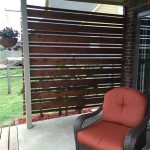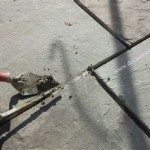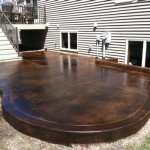How to Upgrade Your Concrete Patio
A concrete patio, a ubiquitous feature in many homes, presents a durable and functional outdoor space. However, its inherent neutrality can sometimes lack visual appeal. Upgrading a concrete patio can significantly enhance a property's aesthetic value and create a more inviting outdoor living area. This article explores several methods for revitalizing a concrete patio, encompassing a range of techniques from simple cosmetic enhancements to more substantial structural modifications.
Cleaning and Surface Preparation
The foundation of any successful patio upgrade lies in thorough cleaning and surface preparation. Neglecting this step can compromise the adhesion and longevity of subsequent treatments. Begin by removing all furniture, potted plants, and debris from the patio surface. A stiff-bristled broom can effectively dislodge loose dirt, leaves, and other superficial contaminants.
For more ingrained dirt and grime, consider using a pressure washer. Exercise caution when operating a pressure washer to avoid damaging the concrete surface. A wide-angle nozzle and moderate pressure setting are generally recommended. Directing a concentrated stream of water at a single point for an extended period can etch or erode the concrete. If a pressure washer is unavailable, a scrub brush and a solution of water and mild detergent can be used. Thorough rinsing with clean water is essential after cleaning.
Inspect the patio surface for cracks and imperfections. Small hairline cracks can often be filled with a concrete crack filler compound. Deeper or wider cracks may require more extensive repair, potentially involving concrete patching or resurfacing. Addressing cracks before applying any surface treatments is crucial to prevent further deterioration and ensure a smooth, even finish.
Consider the presence of stains. Oil stains, rust stains, and other discoloration can detract from the patio's appearance. Specialized concrete stain removers are available for various types of stains. Follow the manufacturer's instructions carefully when using these products, and always test a small, inconspicuous area first to ensure compatibility with the concrete surface.
Surface Treatments and Coatings
Once the patio surface is clean, dry, and repaired, various surface treatments and coatings can be applied to alter its appearance and provide added protection. These options range from simple sealers to more elaborate decorative finishes.
Concrete sealers are a popular choice for enhancing the durability and longevity of concrete patios. Sealers penetrate the concrete pores, creating a barrier against water, stains, and UV damage. They are available in a variety of finishes, including matte, satin, and gloss. Applying a sealer can also enhance the color of the concrete and make it easier to clean. Choose a sealer specifically designed for outdoor concrete surfaces, and follow the manufacturer's instructions regarding application and drying time. Reapplication may be necessary periodically, depending on the type of sealer and the level of exposure to the elements.
Concrete stains offer a way to alter the color of the patio without creating a thick surface coating. Stains penetrate the concrete, creating a permanent color change that won't peel or flake. They are available in a wide range of colors, from natural earth tones to vibrant hues. Acid stains react chemically with the concrete, creating a mottled, variegated appearance. Water-based stains offer a more uniform color and are easier to apply. Before applying a stain to the entire patio, test a small, inconspicuous area to ensure the desired color and effect are achieved. Surface preparation is critical for stain application; the concrete must be clean, dry, and free of any coatings or sealers.
Concrete overlays provide a thicker, more substantial surface coating that can completely transform the look of a patio. Overlays are typically made from a mixture of cement, polymers, and aggregates. They can be applied in a variety of textures and patterns, mimicking the look of natural stone, brick, or tile. Stamped concrete overlays are particularly popular, allowing for the creation of intricate designs and realistic textures. Overlays are typically more expensive than stains or sealers, but they offer a greater degree of design flexibility and can significantly enhance the value of a property. Professional installation is often recommended for concrete overlays to ensure proper application and a durable, long-lasting finish.
Enhancements and Decoration
Beyond surface treatments, a concrete patio can be upgraded through various decorative enhancements and structural modifications. These additions can create a more inviting and personalized outdoor living space.
Adding borders and edging can define the perimeter of the patio and create a more finished look. Borders can be made from a variety of materials, including brick, stone, pavers, or wood. A contrasting color or texture can create a visually appealing accent. Edging can also help to prevent soil erosion and maintain the shape of the patio over time. Consider the overall style of the home and landscape when choosing border and edging materials.
Incorporating outdoor furniture and accessories is essential for creating a comfortable and functional patio space. Choose furniture that is durable and weather-resistant, such as wicker, metal, or teak. Add cushions and throw pillows for added comfort and style. Outdoor rugs can define seating areas and add a touch of color and texture. Consider adding a fire pit or outdoor fireplace for warmth and ambiance. Lighting can also play a significant role in creating a welcoming atmosphere. String lights, lanterns, and spotlights can all be used to illuminate the patio and highlight its features.
Introducing landscaping elements can soften the hard lines of the concrete and create a more natural setting. Potted plants, flower beds, and trees can all be used to add color, texture, and privacy. Consider the amount of sunlight the patio receives when choosing plants. Drought-tolerant plants are a good option for patios in sunny locations. Climbing plants, such as ivy or clematis, can be trained to grow on trellises or walls, adding vertical interest and screening unsightly views. Integrating landscaping can transform a concrete patio from a purely functional space into a tranquil outdoor oasis.
Adding a pergola or awning can provide shade and shelter, making the patio more comfortable to use during hot or rainy weather. A pergola is an open-roofed structure that can be covered with climbing plants for natural shade. An awning is a retractable fabric covering that can be adjusted to control the amount of sunlight. Both pergolas and awnings can add architectural interest to the patio and increase its usability throughout the year. Consider the size and orientation of the patio when choosing a shade structure.

Resurfacing A Concrete Patio For Budget Diy Makeover Fab Everyday

9 Great Concrete Patio Ideas For A Makeover Remodelaholic

5 Ways To Upgrade Your Concrete Patio

Diy Ideas To Update Your Worn Out Concrete Patio Outdoor Backyards

9 Great Concrete Patio Ideas For A Makeover Remodelaholic

Diy Concrete Patio Makeover The Frugal South

Before And After Painted Concrete Patio Thistlewood Farm

Before And After Painted Concrete Patio Thistlewood Farm

How To Upgrade Your Concrete Patio

How To Paint A Concrete Porch Or Patio
Related Posts








